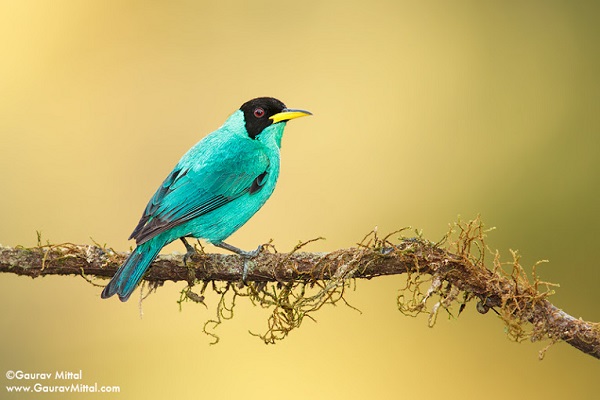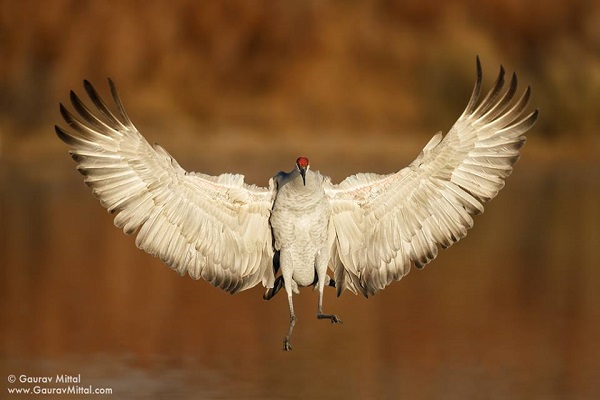Tête-à-tête with Avian Photographer Gaurav Mittal
May 1, 2014He believes in his dream and the journey he treads on. He gave up his lucrative profession and luxury to be with what he loves doing – photographing the most delicate and fragile moments of birds. Gaurav Mittal, an established ‘bird photography artist’ says, ‘his images of birds are not a mere presentation, but a perception of their own reality.’
Gaurav’s works on bird photography have been highlights of popular journals. His recent work on the two Sandhill cranes entitled ‘In-Harmony’ featured on the cover of the Wildlife Photographic Magazine for the month of March 2014. With passion filled with audacious zeal, he profoundly says ‘it is my re-birth and it seems like I’m into photography for 8 years although it has been 2 and ½ years journey of what I chose to be’
In-Harmony : Sandhill Cranes
It is not simple to spot a bird and capture images in its glory, rather Gaurav tries to find a meaning in ‘the whole set-up’ that he sees. For him, they are not only a mere presentation of subject, but a reflection into a photographer’s connection with them. He says, “I do not go out just to shoot bird. I search for a purpose to shoot. Photos should tell a story. I try to find a story to make an imprint. I study bird’s behavior a lot.”
Many birds in urban surrounding depend on us. I look out for situation to capture them
-Gaurav Mittal
Fried Eye took an opportunity to speak about his work, work in progress, his dreams and the moments he cherishes. Avian photography being a niche subject was a bit difficult for us to approach and deal with, especially with the respect and care it deserves. Here we have tried to focus much on Gaurav’s connection with his subject on how his images bring the instinct to be connected to the world of birds.
FE: How do you give a meaning to a bird photograph?
GM: I believe one needs to have a purpose for photography, without which one cannot set goals and aim for images to convey the meaning. I consider the “mood” of an image as a good vehicle for conveying the thought vision. Like, one day in a foggy afternoon in Bharatpur, (India) in a dull atmospheric surrounding, I wandered along a trail when I came across a lonely stork. The soft light and a single stork standing in the vast foggy-scape instantly made me think of solitude and somber nature of that particular scene. I then composed the image and placed the stork close to the Rule of Thirds, including enough area on top to convey the overall mood of the scene. So, I feel that paying attention to the light along with the surrounding landscape and the waiting to capture a bird’s behavior; all these components when woven together give meaning to a photograph.
Eye contact with birds is very special and intimate; it feels as if the bird has opened up its soul. Camera equipments are tools that photographers use to achieve their objectives, it is passion, patience and a desire to succeed which ultimately define success
– Gaurav Mittal
Black-necked Stork as it slowly walked away into the fog. Keoladeo National Park. Bharatpur, India (Out of camera and unprocessed)
In another instances while photographing Green Honeycreepers which weighs an average of 19 grams and 5.5 inches long, the Green Honeycreeper is a small bird in the Tanager family. It is mostly founds in the tropical climates of countries like Mexico, Costa Rica and Brazil. It primarily feeds of fruits, nectar and insects. Photographing in the tropical rain forests of Costa Rica is always a challenge. Given the partially cloudy and sunny conditions most of the times, the ever-changing light requires a constant adjustment to exposure. In order to win in such conditions, it is a must to know to use a flash. The idea behind using the flash is to try and maintain the natural light while making sure that there is only enough fill flash to give the bird enough light while maintaining a natural feel.
The difficulty in shooting a Honeycreeper is to know that one is working on a very skittish bird with a strong blue-tinged green, a black head and a bright yellow bill. If one tries to expose for the black head and then it will overexpose the rest of the bird, on trying to expose the rest of the bird then the details are lost in blacks. This is where the flash comes in handy. I first set the ambient exposure and then worked on getting the flash exposure for the bird on the perch it was constantly landing on. From here on, it’s a matter of patience and observing the bird’s behavior.
Green Honeycreepers, Chlorophanes spiza, Costa Rica
FE: Which one moment during your pursuit, do you remember as ‘The moment’, moment that redefined you and took you to new height?
GM: (Smile) That was the moment! (showing a picture.) Sandhill Cranes are best known for harmony and their behaviors instill togetherness. They are my iconic birds. The ‘Kiss in the Mist’,( showing the picture), does not it, bring romance in mind? It was taken at Bosque, New Mexico in 2011. Although I look out for special moments, they gave me a new meaning to photography.
Sandhill Cranes, Bosbque New Mexico (Processed in colour Efex Pro)
Q. Your blog[1] tells us of many interesting moments at Galapagos. Share us some of your journey capturing moments in that Island.
GM: Galapagos is one of the least visited parts of the world. For me it was an unimaginable experience. It has restricted visitors and one has to travel with a licensed guide. Visitors to the island must disembark far away from the main island leaving the ecology undisturbed. I travelled to the location by boat and was extremely cautioned by the naturalist to be restricted to the set pathways. Trespassing restricted area meant being forbidden from the island.
Birds in the Islands do not have much human interaction. In fact they do not know to react with humans. I brought home not only experience but also stock of ideas. One of my experiences was the dark morph Red-footed Booby- I like the shot because of the dynamic wing position and its posture. If your subject isn’t looking at you then look for interesting pose or behavior in it that will draw you in.
Red-footed Booby in Galapagos
Canon 5D Mark III, Exposure: 1/800sec, F/4.0, Lens 300mm, ISO 1000. Darwin Bay, Genovesa
There was this waived albatross which was spectacular to look at. Endemic to the island, it has enormous capability to fly with its formidable wingspan. The sheer beauty and power of bird in flight is on display and when captured well, reveals the grace and elegance with which birds take to the sky and carry out maneuvers which are no less then breathe taking. (Gaurav at this juncture, literally demonstrated how they fly. He said with one flap they go down for a long distance )
Tropicbird, Galapagos
FE: What are the challenges in bird photography ?
GM: Wildlife photography is a very challenging form of photography. Elements of nature such as weather; lighting conditions and a cooperative subject are not in a photographer’s hand. Many a times, regardless of all the preparations we make, even if one of these elements goes wrong then the photography opportunities are lost. Birds by far are the most difficult subjects to photograph; they are shy, timid and never stay in one place for more than a few seconds. In these situations reading the light, the background and then framing the shot while getting the correct aperture, shutter speed and ISO is very critical, often we come back empty handed and have to keep trying. Logistical planning and long travel schedules also add to the challenge of photography.
Humming bird flutters 5000 per second and it is quite a challenge
– Gaurav Mittal
Q. Which are the birds you are yet to photograph?
GM: Painted Snipe, which is one of the gorgeous female species in the world and are larger than male. The other is the Himalayan Monal largely found in the region of Chopta in Uttarakhand.
FE: What do you aim for being a photographer?
GM: As a photographer, I would be teaching and training the aspirants in bird photography. I would like to give a new meaning to bird photography. I see myself as a conservationist too.
FE: As a bird photographer and conservationist what steps do you take during photography?
GM: I take extreme care not to disturb the ecology of a bird’s habitat. Sometimes one has to take extreme care to avoid shooting in nesting areas.
FE: What message would you like to send to our readers?
GM: Get out and enjoy nature!! Have patience, perseverance, persistence, passion to succeed, not only in photography but in all the fields.
FE: Thank you Gaurav for sharing some wonderful insights. It was delightful to know about your work in this subject.
GM: Thank you
Fried Eye Team wishes Gaurav Mittal very best for his future projects and endeavors in bird photography. He has recently finished capturing images of Marbled Godwitat Morro Bay, New Mexico.
You can find more about him at www.gauravmittal.com
More Bird Photographs by Gaurav Mittal
Willet
Skimmers
“There is no flash involved in this image. The light you see is from the sun peeking through the clouds. If the overall scene is dark and you flash the scene at high power than the background will get dark. I suggest you take a shot first without the flash and get your exposure right for the ambient light, then adjust the power of the flash till you are satisfied with the result.”
– Gaurav Mittal
Sandhill
“I will always have so much love and respect for Sandhill Cranes, they are the reason I’m a photographer”
– Gaurav Mittal.
(As shared with Sanzeeta)
[1] http://gauravmittal.com/bird-photography-trip-galapagos/..
We welcome your comments at letters@friedeye.com












Gaurav has a deep knowledge on his subject of Bird’s photography !
Indeed he has, apart from professional technique, he knows his subject very well, techniques follows